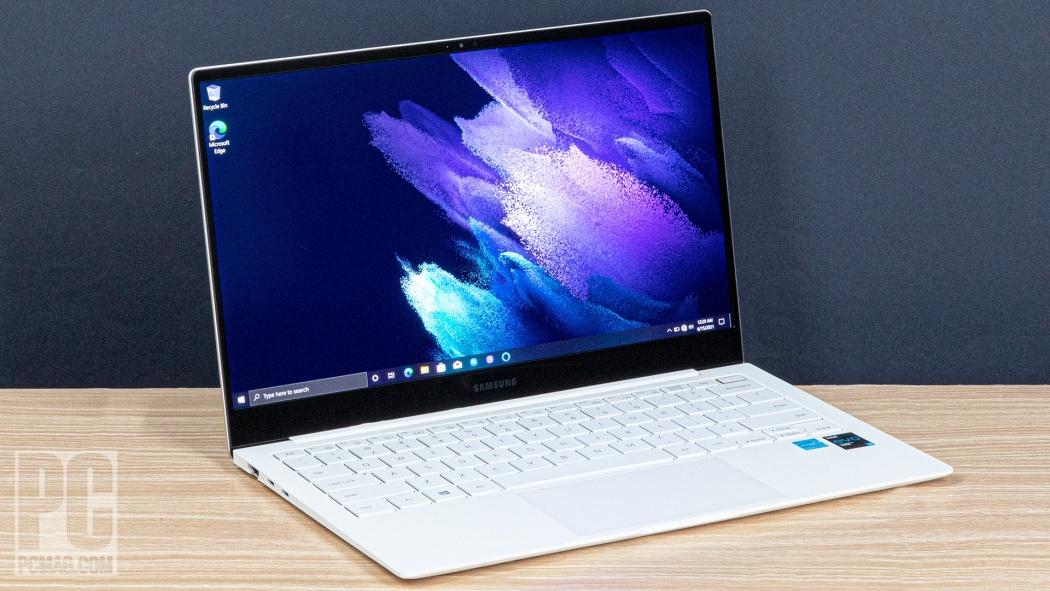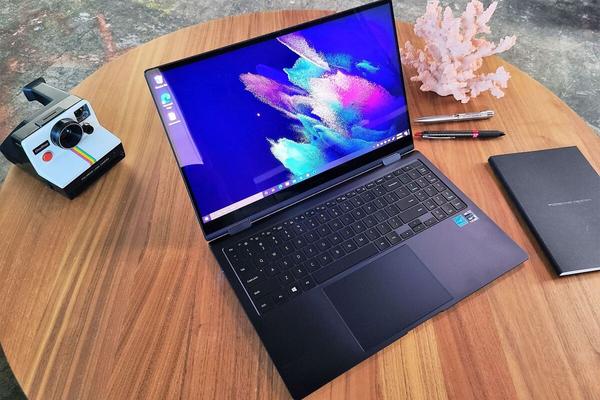
Samsung Galaxy Book Pro 13 Review
We're always happy to see an elegant ultraportable laptop for under $1,000, especially if it has convenient HDMI and USB Type-A ports as well as USB-C/Thunderbolt ports, unlike the class-leading Dell XPS 13. The 13.3-inch Samsung Galaxy Book Pro ($974.99 as tested) not only checks those boxes but boasts a spiffy AMOLED screen like those of Samsung's smartphones, all in a feather-light 1.96-pound package. So why doesn't this review bear our Editors' Choice award insignia? Because the Galaxy Book Pro base model is also the maxed-out model, with 8GB of memory and a 256GB solid-state drive when multitaskers look for double those amounts, especially in this price range. It's a sleek, tempting choice for everyday Microsoft Office and online work, but power users will want something more configurable.
Two Sizes, Two Windows
The Galaxy Book Pro clamshell model (distinguished from the regular Galaxy Book by its AMOLED versus IPS screen technology) is available in 13.3-inch and 15.6-inch display sizes, both with the familiar full HD (1,920-by-1,080-pixel) resolution and 16:9 aspect ratio instead of the taller 16:10 or 3:2 ratios that have become popular of late. Samsung doesn't offer a higher-resolution panel, nor a touch-screen option. Our Windows 10 Pro test unit (model NP930XDB-KH1US) is listed among Samsung's business products for $1,099.99 on sale for $974.99; an otherwise identical consumer model has Windows 11 Home for $999.99.
Our Experts Have Tested 131 Products in the Laptops Category in the Past YearSince 1982, PCMag has tested and rated thousands of products to help you make better buying decisions. (See how we test.)(Photo: Molly Flores)Clad in an aluminum-magnesium alloy the company calls Mystic Silver (with a white keyboard deck), the Intel Evo-compliant laptop combines its 8GB of RAM and 256GB SSD with a quad-core, 2.4GHz Core i5-1135G7 processor. Wi-Fi 6E and Bluetooth are standard, as is a fingerprint reader integrated with the power button (which you may not use much, since opening the lid turns the system on).
Thirteen-inch ultraportables are all roughly the same footprint-size, though the Samsung is one of the trimmest and lightest at 0.44 by 12 by 7.9 inches and 1.96 pounds. The Dell XPS 13 OLED is 0.58 by 11.6 by 7.8 inches and the 2.2-pound HP Pavilion Aero is 0.67 by 11.7 by 8.2 inches. The Galaxy Book Pro's light weight is reflected in its considerable flex if you grasp the screen corners or press the keyboard deck. Its screen bezels are thin but the webcam at top center has no privacy shutter.
4.5Outstanding$1,587.59See Itat DellRead Our Dell XPS 13 OLED (9310) Review 4.5Outstanding$979.00See Itat Amazon Read Our Apple MacBook Air (M1, Late 2020) Review 4.5Outstanding$1,975.32See Itat AmazonRead Our Lenovo ThinkPad X1 Carbon Gen 9 (2021) Review 4.5Outstanding$1,380.00See Itat AmazonRead Our Razer Book 13 Review 4.0Excellent$1,487.40See Itat LenovoRead Our Lenovo ThinkPad X1 Nano Review 4.0Excellent$1,598.00See Itat AmazonRead Our LG Gram 17 (2021) Review 4.0Excellent$427.49 See Itat AmazonRead Our MSI Modern 14 Review 4.0Excellent$999.99See Itat AmazonRead Our Lenovo IdeaPad Slim 7 Carbon Review 4.0Excellent$749.99See Itat AsusRead Our Asus Chromebook CX9 Review 4.0Excellent$899.99See Itat AsusRead Our Asus ZenBook 13 (UM325) Review 4.0Excellent$813.94See Itat AmazonRead Our Lenovo ThinkBook 13s Gen 2 Review4.0Excellent$949.99See Itat Best BuyRead Our Lenovo Yoga 6 (13-Inch) Review 4.0Excellent$695.00See Itat AmazonRead Our Microsoft Surface Laptop Go Review(Photo: Molly Flores)Laptops don't come any thinner than the Samsung, at least not with real ports. An HDMI video output joins two USB Type-C ports, one with Thunderbolt 4 capability, on the left side. One USB 3.2 Type-A port, a microSD card slot, and a headphone jack are on the right. The compact AC adapter has a USB-C connector.
(Photo: Molly Flores)(Photo: Molly Flores)Not the Brightest, But the Best-Looking
The 1080p AMOLED display provides inky blacks and washday-white backgrounds, with phenomenal contrast. (Samsung rates its contrast ratio at 1,000,000:1.) The latter helps the display seem extra-bright, though in reality it didn't excel in our hardware brightness measurement (see the test results below). Colors are rich, vivid, and well saturated, and fine details are clear. Reflections come into play at extreme viewing angles.


Bottom-mounted speakers produce somewhat soft, muffled sound; bass is scanty (drumbeats sound like static), and it's hard to hear overlapping tracks. Audio gets louder and harsher if you turn on the Dolby Access software, which offers music, movie, game, voice, and custom modes and an equalizer.
The backlit keyboard has a shallow but snappy typing feel; it teams the Fn key with the cursor arrows in lieu of dedicated Home, End, Page Up, and Page Down keys. The arrows and top-row keys including Escape and Delete are small. Pressing Fn+F11 cycles through optimized, silent, and high performance cooling-fan modes. (We used the high-performance mode for our benchmarks, except for optimized for the battery test.) The buttonless touchpad glides and taps smoothly but clicks stiffly.
(Photo: Molly Flores)Samsung preloads the Galaxy Book Pro with nearly 20 house-brand apps ranging from security tools (applying an opaque effect to thwart screen snoops or emailing you a photo of anyone who tries to log in while you are away from the machine) to screen color modes (native, sRGB, Adobe RGB, or DCI-P3), plus tools for exchanging files with your Galaxy phone. The most bizarre is Beauty Filter, which works with the webcam to whiten skin or redden lips, apply foundation or blush, or give you a "cute nose" (narrowing your nostrils) or "slim chin" (making you look less jowly). Without the software's help, the 720p camera captures somewhat blotchy, soft-focus images with a fair amount of noise or static.
Testing the Galaxy Book Pro: Trim Ultraportables Put to the Test
For our benchmark round, I pitted the Galaxy Book Pro against the aforementioned HP Pavilion Aero and the Asus ZenBook 13, both of which boast an eight-core AMD Ryzen 7 5800U processor. The remaining two slots went to Lenovo ultraportables with the same Core i5-1135G7 CPU as the Samsung: the ThinkBook 13s Gen 2, and the ThinkPad X13 Gen 2. You can see the contenders' basic specs in the table below.
The main benchmark of UL's PCMark 10 simulates a variety of real-world productivity and content-creation workflows to measure overall performance for office-centric tasks such as word processing, spreadsheeting, web browsing, and videoconferencing. We also run PCMark 10's Full System Drive test to assess the load time and throughput of a laptop's storage. (See more about how we test laptops.)
Three benchmarks focus on the CPU, using all available cores and threads, to rate a PC's suitability for processor-intensive workloads. Maxon's Cinebench R23 uses that company's Cinema 4D engine to render a complex scene, while Primate Labs' Geekbench 5.4 Pro simulates popular apps ranging from PDF rendering and speech recognition to machine learning. Finally, we use the open-source video transcoder HandBrake 1.4 to convert a 12-minute video clip from 4K to 1080p resolution (lower times are better).
Our final productivity test is workstation maker Puget Systems' PugetBench for Photoshop, which uses the Creative Cloud version 22 of Adobe's famous image editor to rate a PC's performance for content creation and multimedia applications. It's an automated extension that executes a variety of general and GPU-accelerated Photoshop tasks ranging from opening, rotating, resizing, and saving an image to applying masks, gradient fills, and filters.
The Samsung underwhelmed in our CPU tests, which were predictably dominated by the eight-core Ryzen 7 chips in the Asus and HP, but easily cleared the 4,000 points that indicate competent office productivity in PCMark 10. It's not the quickest by a long shot, but its gorgeous screen makes it a favorite for Photoshop work, unless you crave higher-than-1080p resolution.
We test Windows PCs' graphics with two DirectX 12 gaming simulations from UL's 3DMark suite: Night Raid (more modest, suitable for laptops with integrated graphics) and Time Spy (more demanding, suitable for gaming rigs with discrete GPUs).
We also run two tests from the cross-platform GPU benchmark GFXBench 5, which stresses both low-level routines like texturing and high-level, game-like image rendering. The 1440p Aztec Ruins and 1080p Car Chase tests, rendered offscreen to accommodate different display resolutions, exercise graphics and compute shaders using the OpenGL programming interface and hardware tessellation respectively. The more frames per second (fps), the better.
Intel's 11th Generation Iris Xe integrated graphics are perkier than their predecessors and their AMD rivals, but fall far short of even a lower-end discrete GPU. None of these ultraportables is in the same ZIP code as a true gaming laptop when it comes to playing fast-paced titles, though they're suitable for casual games and streaming video and audio. (For more on that topic, see our deep dive on laptop integrated graphics in 2021.)
We test laptops' battery life by playing a locally stored 720p video file (the open-source Blender movie Tears of Steel) with display brightness at 50% and audio volume at 100%. We make sure the battery is fully charged before the test, with Wi-Fi and keyboard backlighting turned off.
We also use a Datacolor SpyderX Elite monitor calibration sensor and its Windows software to measure a laptop screen's color saturation—what percentage of the sRGB, Adobe RGB, and DCI-P3 color gamuts or palettes the display can show—and its 50% and peak brightness in nits (candelas per square meter).
The Galaxy Book Pro's display may show only 323 nits at peak brightness in SpyderX testing instead of the 400-plus we usually look for, but its AMOLED technology makes it appear much brighter, and its color fidelity is off the charts. Laptop screens—at least full HD as opposed to 4K screens—don't come any better. The Samsung also tied with the ThinkPad for the most outstanding battery life, able to get you through not one but two full days of work or school.
Verdict: Fine and Feathery, But Not Future-Proof
Of course it's a Windows laptop, but as odd as it sounds, we found ourselves thinking of the super-light Samsung Galaxy Book Pro as if it were a really great Chromebook—too short on horsepower, memory, and storage for demanding content creation or video editing jobs, but a pleasure to use for everyday word processing, spreadsheeting, presentations, email, and browsing.
(Photo: Molly Flores)It doesn't earn our highest recommendation because there are too many great ultraportables that can be configured with 16GB of RAM or 1TB SSDs, but it fills a nice niche at a reasonable price.
3.5See It$813.85 at AmazonPrice as Tested $974.99View MoreIt's better for low-impact office-productivity work than demanding content creation, but Samsung's AMOLED-screened Galaxy Book Pro is an appealing two-pound traveling partner.
Sign up for Lab Report to get the latest reviews and top product advice delivered right to your inbox.
EmailThis newsletter may contain advertising, deals, or affiliate links. Subscribing to a newsletter indicates your consent to our Terms of Use and Privacy Policy. You may unsubscribe from the newsletters at any time.
Thanks for signing up!Your subscription has been confirmed. Keep an eye on your inbox!
}})